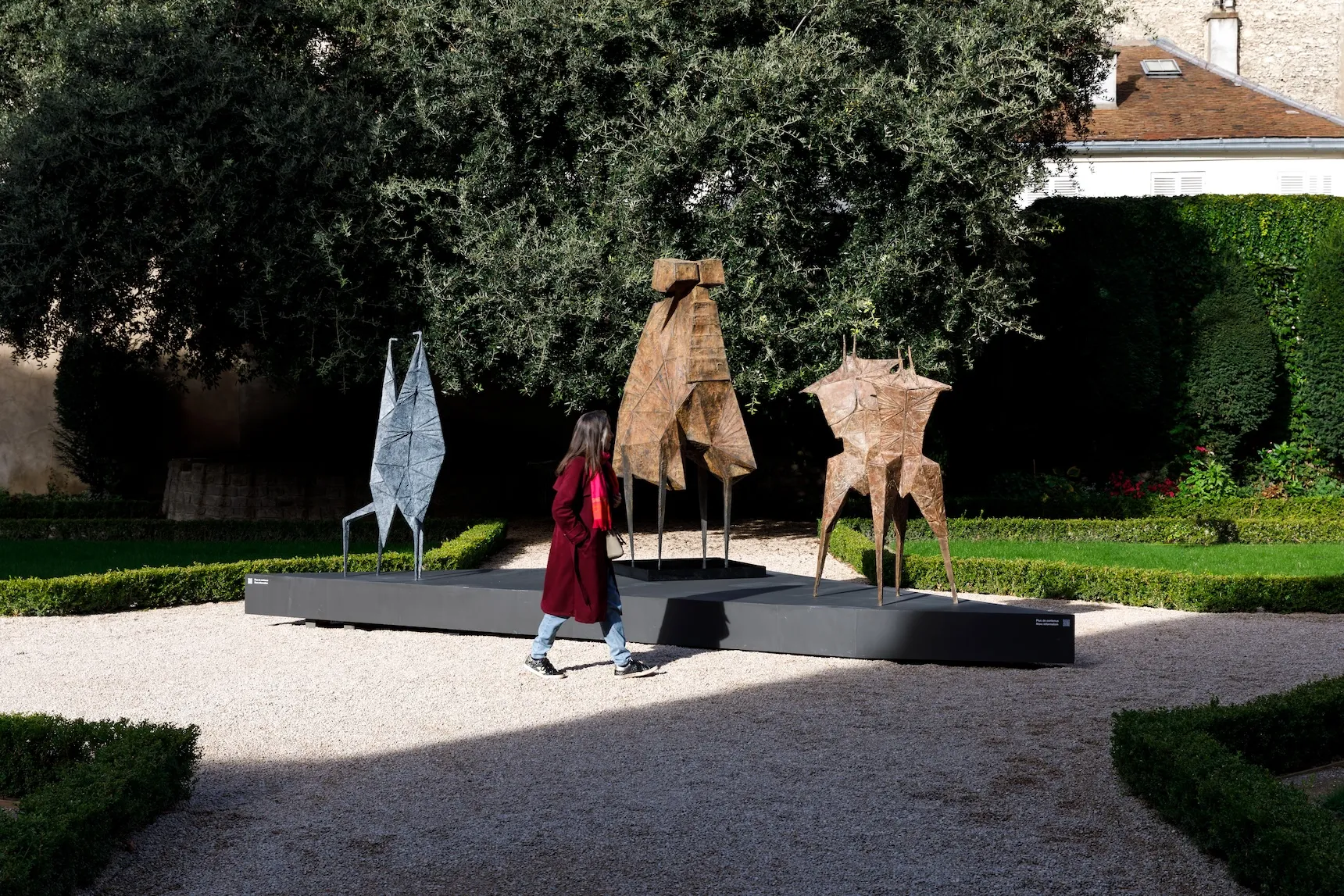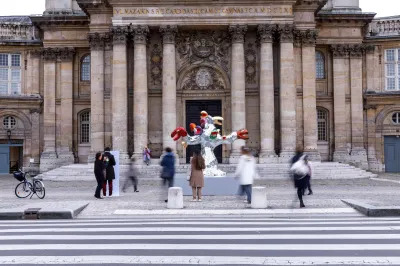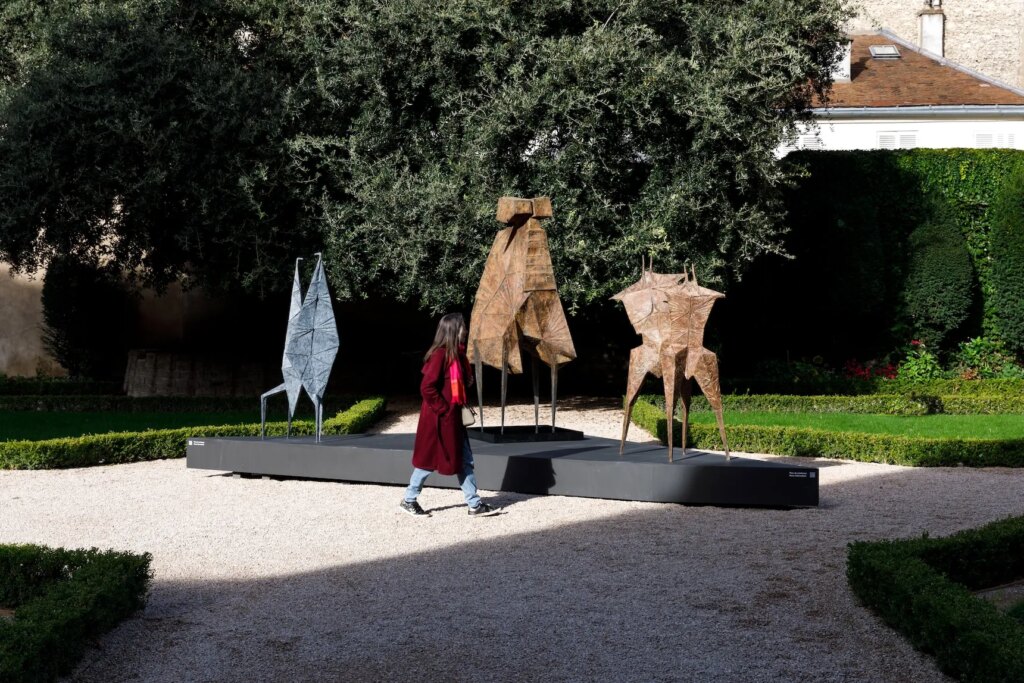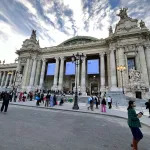
Art Basel Paris, which runs from October 18 to 20 (with VIP days on 16 and 17), has left behind its inaugural name and old location—Paris+, par Art Basel and the Grand Palais Éphémère, respectively—this year for a fresh start. Now based at the Grand Palais, the fair is accompanied by a public program of free exhibitions, installations, and conferences at nine venues.
In front of the Hôtel de la Marine stands a kinetic sculpture by Greek artist Takis. The Petit Palais features British artist Jesse Darling, the winner of the 2023 Turner Prize. In the Avenue Winston-Churchill, there is a contorted aluminum sculpture from John Chamberlain’s “Foils” series, a giant pumpkin by Japanese legend Yayoi Kusama, and one of Jean Prouvé’s iconic houses. The Hôtel de Sully is presenting sculptures by Lynn Chadwick, and the Palais-Royal Garden is home to contemporary installations by César, Thomas Schütte, and Ghada Amer.
These are all new venues for the Paris fair’s public programming, though this year, Art Basel continued on with a few old venues as well.
The Palais d’Iéna, for example, has a project called “Tales & Tellers,” which is being presented by Miu Miu, the sponsor of the section. Artist Goshka Macuga and Elvira Dyangani Ose, the director of Barcelona’s MACBA, were entrusted with this project, and here exploring the concept of femininity based on videos, performances, and panels. In front of the Institut de France stands Abre-Serpents by Niki de Saint Phalle, the subject of a newly released biopic and a forthcoming retrospective that will open at the Grand Palais next spring. The Musée Eugène-Delacroix is filled with works by Lebanese filmmaker Ali Cherri, and French sculptor Jean-Charles Quillacq has taken over the Chapelle des Beaux-Arts de Paris.
Have questions about any of this? Between October 16 and 20, you can pose your queries to art history students from the prestigious École du Louvre, who will stationed at these venues. But should you want to get your thoughts together before to doing so, have a look at Art Basel’s programming at five of these venues, below.

Palais d’Iéna
The Palais d’Iena, one of the three buildings that the Palais de Tokyo and the Palais de Chaillot inherited from the 1937 Exposition Universelle, serves as a set for Miu Miu’s “Tales & Tellers”, the official sponsor for Art Basel Paris’s public program. Macuga’s project pays homage to “Women’s Tales,” a Miu Miu–commissioned series of short films directed by women, with each narrative enacted by real-life actresses.
Some 30 women, some standing in for female stereotypes, attend to their businesses on the third floor of the Palais d’Iéna, where fiction and reality collide. One skates, another seems to be working out, two intermittently sing. All end up dancing and parading together. The longer they stay, the more visitors start to blend in, to such point that it becomes hard to tell who is passing by and who is performing. “Tales & Tellers” also includes screenings of all commissioned videos, as well as a program of conversations featuring some of the filmmakers and artists who have been collaborating with Miu Miu for over a decade.
Domaine National du Palais-Royal
The Tuileries Garden, a prior venue of Art Basel Paris’s public program was left unavailable as a venue because of the deconstruction of the Olympics’ facilities, and that’s how the fair ended up with the Palais-Royal, a quaint park near the Comédie Française theater. Past Paul Lemoyne’s Le Pâtre et la Chêvre (1830), a sculptural depiction of a shepherd with a goat, stand three minimalist iron panels by Brazilian artist Amilcar de Castro (1920–2002), whose works involved slicing and bending metal sheets like newspapers, without altering or soldering the material in any way. Above this delicate yet solid installation, on the same manicured lawn, Galleria d’Art Maggiore G.A.M. has planted seven totem-like bronze figures by Chilean artist Roberto Matta (1991–2009), a Surrealist currently featured in a Centre Pompidou blockbuster.

Institut de France
On the Seine’s Left Bank, the Institut de France, which includes five academies under its umbrella, has a paved forecourt featuring a dazzling sculpture by Niki de Saint Phalle. However, this is not the first time the French American artist has been selected for the fair’s public program. Two years ago, Galerie Georges-Philippe and Nathalie Vallois had brought her Blue Obelisk with Flowers (1992) to the Tuileries Garden. This year, Galerie Mitterrand has settled on Arbre-Serpents (1992), a glistening tree with a dozen colorful, snake-shaped branches, all covered in mirror fragments, glass mosaic, and gold leaf. The fang-free reptiles seem more playful than harmful. This hypnotic work is part of a series that de Saint Phalle started in the early 1980s to overcome her ophiophobia, or a fear of snakes. The earlier iteration of the sculpture, from 1982, belongs to her Tarot Garden, in Tuscany.
Chapelle des Petits-Augustins des Beaux-Arts de Paris
Five minutes away from the Institut de France is the Chapelle des Petits-Augustins, a 17th century convent built for Queen Margot (1553-1615), Henri IV’s first wife, and part of the Beaux-Arts de Paris. This venue, which was previously part of the fair’s off-site circuit, is home to sculptures by Jean-Charles de Quillacq (b. 1979). “When I make my sculptures, I use as little technique as possible, and I work in a very basic way,” De Quillacq stated on his website. “My sculptures all have a strong connection with the human body, and I use the word ‘postures’ for the spatial positions that I give them.”
The French artist, whose research focuses on the body, its representation, and social organization, has placed pieces of bread, large cigarette butts, and long organic forms in dialogue with the museum’s permanent collection of medieval and Renaissance casts. The mannequin pictured on the left with socks up to its calves and a bag covering half of its face acts as a metaphor for the inconsistent and ambivalent nature of capitalism.
Petit Palais
The Petit Palais is where the Conversations program takes place, but also where Jesse Darling has dropped anchor. He’s exhibiting VANITAS installation (2024), which was presented last year in London after his 2023 Turner Prize win and consists of twisted metal barriers. Those distorted objects, originally intended to prevent access or movement, symbolize here the fragility of the power structures they embody. Glass cases filled with flowers slowly decaying from Darling’s series “still life” (2018-ongoing), occupy the opposite gallery. Together both projects highlight the precarity of authority, as its wielders are easily replaced, and the vulnerability of natural life.


